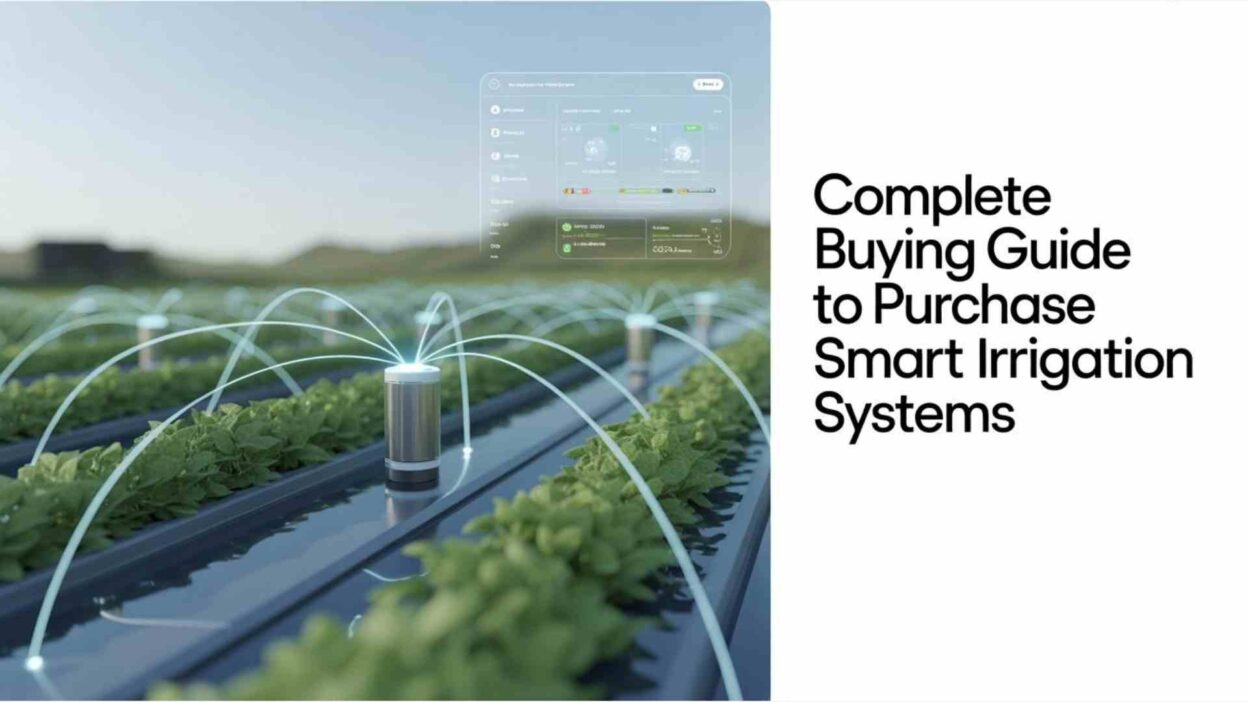TL;DR Homeowners waste thousands of gallons of water each year through inefficient watering. Traditional irrigation systems run on fixed schedules regardless of weather conditions. Rain falls while sprinklers simultaneously soak lawns, creating unnecessary runoff. Manual adjustments require constant attention and expertise, which most people lack.
Table of Contents
Smart irrigation technology revolutionizes landscape water management. These systems adjust watering schedules based on real-time weather data. Soil moisture sensors detect when plants actually need water. Mobile apps provide complete control from anywhere in the world. The technology saves water, reduces bills, and maintains healthier landscapes.
Deciding to purchase smart irrigation systems represents a significant home improvement investment. Numerous brands offer competing features at varying price points. Understanding your specific needs helps navigate the overwhelming selection. This comprehensive guide explains everything you need to make an informed buying decision.
Understanding Smart Irrigation Technology
Smart irrigation systems use sensors and connectivity to optimize water usage. Weather-based controllers access internet forecasts, adjusting schedules automatically. Soil moisture monitors measure actual ground conditions. Flow sensors detect leaks, preventing water waste and property damage.
The technology connects to home WiFi networks, enabling remote control. Smartphone apps display current watering status and allow instant adjustments. Some systems integrate with smart home platforms like Alexa and Google Home. Voice commands provide convenient hands-free operation.
Machine learning capabilities improve system performance over time. The controller learns landscape-specific watering needs through observation. Adjustments happen automatically without requiring user intervention. This intelligence delivers better results than manual programming ever could.
Weather-Based Controllers
Weather-based systems access local forecast data through internet connections. Rain predictions trigger automatic schedule cancellations. Temperature readings adjust watering duration based on evaporation rates. Wind forecasts modify schedules, preventing water waste through drift.
EPA WaterSense certification identifies qualified weather-based controllers. These products meet strict efficiency and performance criteria. WaterSense systems typically reduce outdoor water use by 20% or more. The certification provides assurance when you purchase smart irrigation systems.
Historical weather data informs baseline watering schedules. The system analyzes typical conditions for your specific location. Seasonal adjustments happen automatically as weather patterns shift. This dynamic approach eliminates manual seasonal reprogramming.
Soil Moisture Sensing Technology
Soil sensors measure actual moisture levels at root depth. The system waters only when readings drop below optimal thresholds. This precision prevents both overwatering and underwatering. Plant health improves while water consumption decreases significantly.
Wireless sensors transmit data to the central controller continuously. Multiple sensors monitor different landscape zones independently. Clay soil areas receive different treatment than sandy sections. This zone-specific approach optimizes conditions throughout your entire property.
Installation depth affects sensor accuracy and performance. Shallow placement misses deeper root zones. Proper depth varies by plant type and root structure. Professional installation ensures sensors sit at optimal depths.
Assessing Your Property and Needs
Every landscape presents unique irrigation requirements and challenges. Property size determines system capacity and zone quantity needs. Terrain slope affects water distribution and runoff potential. Sun exposure patterns influence evaporation rates across different areas.
Plant variety impacts watering frequency and duration requirements. Established trees need less frequent deep watering. Flower beds require more regular light watering. Vegetable gardens demand precise moisture management for optimal yields. Understanding these differences helps you purchase smart irrigation systems that match your landscape.
Existing irrigation infrastructure influences upgrade options and costs. Properties with traditional automatic systems need controller replacements only. Landscapes relying on manual watering require a complete system installation. Hybrid approaches can phase implementation across multiple seasons.
Zone Configuration Planning
Irrigation zones group plants with similar water requirements together. Sunny slopes form separate zones from shaded valley areas. Native drought-tolerant plants water independently from thirsty annuals. Proper zoning maximizes efficiency and plant health simultaneously.
Zone quantity affects system complexity and cost. Small yards might need only two or three zones. Large properties could require ten or more distinct areas. Controllers specify maximum zone capacity, limiting expansion potential.
Valve placement impacts installation costs and system reliability. Central valve manifolds simplify maintenance but increase pipe runs. Distributed valves reduce piping but complicate troubleshooting. Your property layout guides optimal valve configuration.
Water Source and Pressure Considerations
Municipal water supplies provide consistent pressure and flow rates. Well systems might have variable pressure requiring regulation. Pressure too high damages components and wastes water. Insufficient pressure creates uneven coverage and dry spots.
Flow rate determines how many zones can operate simultaneously. Sprinkler head specifications require minimum flow volumes. Total property demand might exceed available flow capacity. Proper design sequences zones, preventing pressure drops.
Backflow prevention protects potable water supplies from contamination. Local codes typically require approved backflow devices. Professional installation ensures compliance with regulations. This safety feature adds cost but provides essential protection.
Key Features to Evaluate
Smart irrigation systems offer varying feature sets at different price points. Basic models provide weather-based scheduling and mobile control. Advanced systems add soil sensors, flow monitoring, and predictive analytics. Understanding which features matter most helps you purchase smart irrigation systems that match your needs.
Mobile app quality significantly impacts user experience. Intuitive interfaces make scheduling adjustments simple. Confusing apps frustrate users, reducing smart system benefits. Reading user reviews reveals app usability before buying.
Integration capabilities extend functionality through smart home connections. Alexa compatibility enables voice control convenience. Google Home integration centralizes smart home management. IFTTT support allows custom automation creation.
Watering Schedule Customization
Flexible scheduling accommodates diverse landscape needs. Multiple programs allow different watering frequencies per zone. Seasonal adjust features shift durations as weather patterns change. Cycle-and-soak options prevent runoff on slopes and clay soils.
Manual override capabilities provide control when automation needs adjustment. One-touch rain delay postpones schedules without reprogramming. Individual zone testing helps troubleshoot coverage problems. These manual controls complement automated intelligence.
Historical reporting shows actual watering activity over time. Water usage tracking quantifies conservation achievements. Schedule adjustment logs document the system learning progress. This data helps optimize performance and demonstrates return on investment.
Remote Access and Control
WiFi connectivity enables smartphone control from anywhere. Adjust schedules while traveling without relying on neighbors. Respond to unexpected weather changes immediately. This flexibility prevents water waste and maintains landscape health.
Push notifications alert users to important system events. Low water pressure warnings indicate potential leaks. Completed watering cycles confirm successful operation. Rain delay notifications explain schedule cancellations.
Multiple user support allows family members individual access. Permission levels restrict unauthorized schedule changes. Kids can activate zones for play without disrupting programs. This access control balances convenience with system protection.
Brand Comparison and Market Leaders
The smart irrigation market includes established brands and innovative newcomers. Rachio dominates consumer smart controller sales through a user-friendly design. Rain Bird offers professional-grade reliability at premium prices. Orbit provides budget-friendly options with essential smart features.
Brand reputation indicates likely product quality and support levels. Established companies provide extensive dealer networks and technical support. Startup brands might offer cutting-edge features but uncertain longevity. Your risk tolerance guides brand selection when you purchase smart irrigation systems.
Compatibility with existing equipment varies by brand. Some controllers work with any standard irrigation valves. Others require proprietary components, limiting flexibility. Universal compatibility provides future upgrade flexibility.
Rachio Smart Controllers
Rachio controllers feature exceptionally intuitive mobile apps. Setup wizards guide users through initial configuration steps. Weather intelligence adjusts schedules using hyperlocal forecast data. The system earns consistent praise for ease of use.
Multiple controller models suit different property sizes. The base model handles eight zones, sufficient for typical homes. Expanded versions manage sixteen zones for larger properties. All models include core smart features and app control.
Rachio integrates seamlessly with major smart home platforms. Alexa skills enable voice control of zones and schedules. Google Assistant support provides similar functionality. IFTTT recipes create custom automation triggers.
Rain Bird Smart Systems
Rain Bird brings decades of professional irrigation expertise to smart technology. Their controllers combine reliability with intelligent features. Professional landscapers trust Rain Bird for commercial installations. This pedigree translates to residential product quality.
Weather-based scheduling uses localized weather station data. Optional wireless soil moisture sensors add precision. Flow monitoring capabilities detect system leaks automatically. These professional features justify premium pricing.
Rain Bird offers comprehensive product ecosystems beyond controllers. Smart-compatible valves, sensors, and sprinklers optimize performance. Matched components eliminate compatibility concerns. This integration appeals to those who purchase smart irrigation systems seeking complete solutions.
Budget-Friendly Alternatives
Orbit and other value brands provide smart features at accessible prices. Basic WiFi controllers cost under $100, making entry affordable. Feature sets focus on essentials rather than advanced capabilities. Budget options suit homeowners wanting smart benefits without premium costs.
Performance and reliability vary among budget brands. Some provide excellent value while others disappoint users. Third-party reviews help identify quality budget options. Saving money up front makes sense only if the system performs reliably.
Upgrade paths matter when starting with budget systems. Expandability allows adding sensors and zones later. Proprietary ecosystems might limit future enhancement options. Consider long-term flexibility when evaluating initial savings.
Installation Options and Requirements
Professional installation ensures optimal system performance and reliability. Experienced technicians place sensors correctly and program systems properly. This expertise prevents common mistakes that compromise efficiency. Installation costs typically range from $500 to $2,000, depending on complexity.
DIY installation saves money but requires time and basic skills. Controller replacement involves simple wire connections. Complete system installation demands trenching and pipe installation knowledge. Your skill level and available time determine the best approach.
Hybrid installation strategies balance cost savings with expertise. Homeowners might handle controller replacement while hiring pros for sensor installation. This approach reduces costs while ensuring critical components work correctly. Flexibility in approach helps you purchase smart irrigation systems within budget.
DIY Installation Considerations
Controller replacement represents the simplest DIY smart irrigation upgrade. Existing wiring connects to new smart controller terminals. Wire labels prevent connection mistakes during replacement. Most homeowners complete this swap in under an hour.
Sensor installation requires burying probes at the proper depths. Wireless models simplify installation, avoiding trenching for data cables. Locating sensors in representative areas improves accuracy. Poor placement compromises system performance despite quality equipment.
System programming challenges even technically capable homeowners. Understanding zone characteristics requires irrigation knowledge. Incorrect settings waste water despite smart technology. Online tutorials and manufacturer support help overcome learning curves.
Professional Installation Benefits
Licensed irrigation contractors bring expertise beyond basic installation. They assess property drainage and adjust grading if needed. Proper sprinkler head selection ensures even coverage. This attention to detail maximizes system effectiveness.
Warranty coverage often requires professional installation documentation. Manufacturers protect themselves against DIY installation mistakes. Professional work provides recourse if problems develop. This protection justifies installation costs for many homeowners.
Ongoing maintenance services keep systems performing optimally. Annual spring startups and fall winterizations prevent damage. Professionals spot developing problems before failures occur. These services extend system’s lifespan significantly.
Cost Analysis and Budgeting
Smart irrigation system costs vary dramatically based on scope and features. Controller-only upgrades start around $150 for basic models. Complete new system installations can exceed $5,000 for large properties. Understanding cost components helps you purchase smart irrigation systems within budget.
Hardware expenses include controllers, valves, sensors, and sprinklers. Controllers range from $100 to $500, depending on features. Soil sensors add $50 to $200 per unit. Flow meters cost $100 to $300. These components form the system foundation.
Installation labor represents a significant expense for complete systems. Professional installation averages $30 to $50 per zone. Complex properties with difficult access cost more. Flat terrain with easy access reduces labor time and costs.
Return on Investment Calculations
Water bill savings offset smart system costs over time. Average outdoor water use reductions reach 20% to 50%. A household spending $100 monthly on water saves $20 to $50. Annual savings of $240 to $600 make payback periods reasonable.
Landscape health improvements provide additional value. Proper watering reduces plant replacement costs significantly. Healthier lawns resist weeds and disease naturally. These indirect benefits compound direct water savings.
Property value increases from quality irrigation systems. Smart home features appeal to modern homebuyers. Well-maintained landscapes enhance curb appeal and perceived value. These factors justify investment beyond simple water savings.
Financing and Incentive Programs
Water utility rebate programs subsidize smart irrigation adoption. Many municipalities offer $50 to $200 rebates for WaterSense controllers. Some provide additional incentives for soil sensors and rain sensors. These rebates significantly reduce net costs when you purchase smart irrigation systems.
Manufacturer promotions during spring provide seasonal discounts. Black Friday and Prime Day deals offer substantial savings. Patience in timing purchases can save hundreds of dollars. Off-season buying sometimes yields the best prices.
Home improvement financing options spread costs over time. Credit cards with promotional interest rates defer payment. Home equity lines leverage property value for improvements. Payment plans make larger investments more manageable.
Water Conservation and Environmental Impact
Smart irrigation technology addresses critical water scarcity concerns. Outdoor watering represents 30% to 50% of residential water consumption. Much of this usage goes to waste through overwatering and runoff. Intelligent systems dramatically reduce this waste.
Environmental benefits extend beyond direct water conservation. Reduced pumping and treatment needs lower energy consumption. Less fertilizer runoff protects waterways from nutrient pollution. Healthier plants sequester more carbon, improving air quality.
Community-wide smart irrigation adoption creates regional impact. Municipal water systems operate more efficiently with reduced peak demand. Aquifer recharge improves when consumption decreases. These collective benefits justify public rebate programs.
Drought Resilience
Water restrictions during droughts often exempt smart irrigation users. Systems demonstrating efficiency receive exemptions from odd-even watering rules. This flexibility maintains landscape health during challenging conditions. Compliance with restrictions becomes automatic rather than burdensome.
Deep-rooted plant health improves drought tolerance naturally. Proper watering encourages deeper root growth. Smart systems prevent shallow roots from inadequate watering. This root development prepares landscapes for water scarcity.
Native plant landscaping combined with smart irrigation maximizes sustainability. Drought-adapted species require minimal supplemental water. Smart systems provide only the necessary irrigation. This combination creates beautiful low-water landscapes.
Reducing Runoff and Erosion
Cycle-and-soak watering prevents runoff on slopes and compacted soil. Short watering cycles allow absorption before additional application. Multiple cycles deliver the required water without waste. This approach protects soil structure and water quality.
Flow monitoring detects broken sprinkler heads and line breaks. Immediate notifications prevent gallons of waste and property damage. Quick response limits erosion from uncontrolled water flow. This protection preserves landscape investment.
Rain delay features prevent watering saturated soil. Oversaturated ground cannot absorb additional water. Smart systems recognize this condition automatically. Delayed schedules prevent unnecessary runoff and waste.
Smart Home Integration Possibilities
Modern smart irrigation systems connect with broader home automation ecosystems. Voice assistants control watering through simple commands. Smart home hubs centralize irrigation within comprehensive automation. This integration increases convenience and enables advanced automation.
Weather station integration provides hyperlocal data for adjustments. Personal weather stations deliver more accurate information than distant airports. Direct sensor connections bypass internet forecasts. This local precision optimizes watering decisions.
Security system integration creates intelligent automation scenarios. Vacation modes adjust schedules when the home security system arms. Leak detection triggers automatic zone shutdowns. These connections enhance both convenience and protection.
Voice Control Capabilities
Alexa integration enables hands-free irrigation control. Voice commands activate zones for kids’ play or garden watering. Schedule inquiries provide status without opening apps. This convenience enhances smart irrigation benefits.
Google Assistant provides similar voice control functionality. Routine integration includes irrigation in morning and evening automations. Broadcast features announce watering status to family members. These capabilities suit Google Home ecosystem users.
Siri Shortcuts create custom voice commands on Apple devices. Homeowners personalize control phrases matching their preferences. Complex multi-step sequences are executed with single commands. This flexibility appeals to iOS users who purchase smart irrigation systems.
Advanced Automation Scenarios
IFTTT recipes create custom triggers beyond standard features. Watering could pause when gates open, indicating yard activity. Schedule adjustments could follow pool chlorination timing. Creative automation possibilities are nearly endless.
Smart home scenes include irrigation alongside lighting and climate. Evening watering coordinates with outdoor lighting schedules. Morning routines could check moisture levels before deciding to water. Holistic automation optimizes entire property management.
Weather service integration enables proactive storm preparation. Severe weather alerts could trigger irrigation shutdowns. Hurricane preparations could include automatic system winterization. These automations protect property and conserve resources.
Maintenance and Troubleshooting
Smart irrigation systems require less maintenance than traditional controllers. Automatic adjustments eliminate seasonal reprogramming. Remote monitoring identifies problems without physical inspections. However, some maintenance remains necessary for optimal performance.
Sensor cleaning and calibration maintain accuracy. Soil moisture probes accumulate mineral deposits over time. Annual cleaning removes buildup, restoring sensitivity. Calibration verification ensures readings match actual conditions.
Software updates improve functionality and security. Manufacturers release updates addressing bugs and adding features. Automatic updates happen seamlessly without user intervention. Keeping systems current maximizes performance and protection.
Common Issues and Solutions
WiFi connectivity problems prevent remote access and weather updates. Router distance or interference disrupts communication. Range extenders or mesh networks solve coverage issues. Strong connectivity ensures that full smart features work properly.
Sensor reading errors cause inappropriate watering decisions. Damaged probes send incorrect data to controllers. Physical damage from digging or equipment requires replacement. Proper sensor placement protects against accidental damage.
App syncing failures prevent control and monitoring. Server outages temporarily disable cloud-based features. Local control modes provide backup during connectivity issues. Quality systems include offline operation capabilities.
Seasonal Maintenance Tasks
Spring startups involve system inspection and testing. Controllers reconnect to WiFi after power outages. Sprinkler head cleaning removes winter debris. System testing identifies winter damage requiring repair.
Fall winterization prevents freeze damage in cold climates. Water line blowouts remove residual water from pipes. Controller shutdown procedures vary by model. Proper winterization protects investment through harsh weather.
Mid-season inspections catch developing problems early. Visual checks identify damaged or misaligned sprinkler heads. Coverage pattern verification ensures even watering. Proactive maintenance prevents minor issues from becoming major problems.
Making Your Final Purchase Decision
Comparing researched options against specific needs reveals the best choice. Feature priorities vary by property and user preferences. Budget constraints eliminate some options, while others exceed requirements. Balancing these factors leads to optimal selection.
Reading detailed reviews from actual users provides valuable insights. Professional reviews lack a long-term ownership perspective. Customer feedback reveals durability and support quality. Both positive and negative reviews inform purchasing decisions.
Warranty coverage protects against defects and early failures. Length and terms vary significantly across brands. Comprehensive warranties demonstrate manufacturer confidence. This protection matters when you purchase smart irrigation systems representing a significant investment.
Where to Buy
Online retailers offer competitive pricing and extensive selection. Amazon provides customer reviews and easy comparison shopping. Manufacturer websites occasionally offer exclusive deals. Online shopping convenience appeals to many buyers.
Local irrigation supply stores provide expert advice and support. Staff experience helps match systems to specific needs. Relationship-building enables ongoing assistance. Local purchasing supports community businesses.
Home improvement chains balance selection with accessibility. In-stock availability enables immediate installation starts. Return policies provide safety nets for mismatched purchases. These familiar retailers comfort some buyers.
Timing Your Purchase
Spring represents peak buying season with promotional pricing. Manufacturers compete for attention during high-demand periods. Installation availability becomes limited during rush. Early spring shopping beats the crowd.
Off-season purchasing during fall or winter yields better deals. Inventory clearance sales offer significant discounts. Installation scheduling proves easier with reduced demand. Patient buyers save substantially through timing.
Prime Day and Black Friday sales provide deep discounts. Online retailers heavily promote smart home products. Irrigation controllers frequently appear in deal lists. These events reward prepared shoppers who purchase smart irrigation systems strategically.
Read More: Top 7 Software Integrations for Enterprise Businesses
Conclusion

Smart irrigation technology transforms landscape water management fundamentally. Weather-based scheduling eliminates waste from unnecessary watering. Soil moisture sensors ensure plants receive optimal hydration. Mobile control provides convenience and flexibility unprecedented in traditional systems.
Installation approaches range from complete DIY to full professional service. Controller replacement represents accessible entry points for most homeowners. Complete system installations benefit from professional expertise and warranty protection. Hybrid strategies balance cost savings with quality assurance.
Environmental consciousness increasingly drives consumer technology adoption. Smart irrigation aligns personal interest with societal benefit. Water scarcity concerns affect growing portions of the population. Individual action through smart systems contributes to collective conservation.
Technology advancement continues to improve smart irrigation capabilities. Machine learning enhances system intelligence over time. Sensor accuracy improves through engineering innovation. Future systems will deliver even greater efficiency and convenience.
Professional consultation provides personalized guidance for complex properties. Irrigation contractors assess specific conditions and recommend solutions. Their expertise prevents costly mistakes from uninformed purchases. Free estimates and consultations risk nothing while providing valuable information.






[…] Read More: Complete Buying Guide to Purchase Smart Irrigation Systems […]